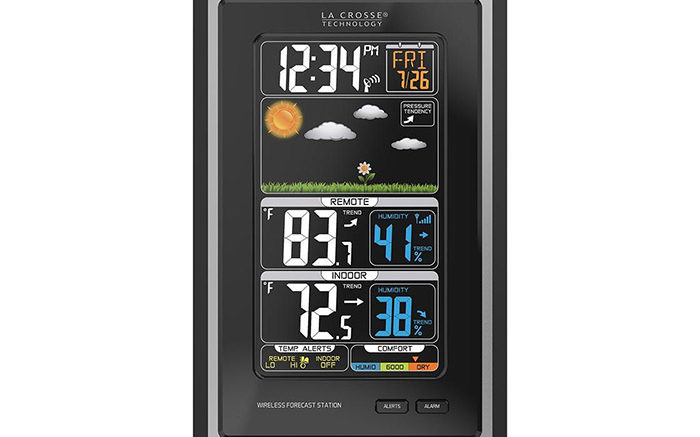Yes, I know you have a weather app on your phone. You might even have more than one. If you’re a DIRECTV customer you have weather apps on your TV as well.
Weather apps are great but…
Weather apps are great. Sometimes they’re even entertaining. But they aren’t perfect. They don’t really tell you the weather where you’re standing, and it doesn’t tell you what the temperature is inside the house either. You need a weather station for that, and the good news is that there are some great ones available at Solid Signal. But it may take a little bit of research to really understand what you’re looking at.
The La Crosse weather station you see above shows you both temperature and relative humidity. (It’s not absolute humidity, which is a completely different thing and useful for other reasons.) But what is relative humidity? I mean, what happens when it gets to 100%?
A simple description of relative humidity
In order to understand relative humidity, you have to understand dew point, which is actually a much better measurement of the amount of water that’s in the air. Dew point tells you the temperature at which the water in the air will condense and turn to rain or snow, and a higher dew point means more water vapor in the air. It also means that it “feels” more humid to you.
Relative humidity is more important in actual weather, even though it can have less to do with how you actually feel. Relative humidity, to make it really simple, describes how close your current temperature is to the current dew point. If your current temperature is also the current dew point, then your relative humidity is 100% and it’s probably going to rain any second.
What does relative humidity mean when it comes to understanding weather?
Weather is a funny thing because there’s no one number that says that it’s going to be good weather or bad weather; of course no two people will agree on what good weather is anyway. But if you know temperature and relative humidity, you’re on your way to knowing if you’re going to get wet. Barometric pressure is another piece of that puzzle, which is why it’s important to know if the trend is moving up or down. Low barometric pressure usually means storms, if the dew point is high enough, while high barometric pressure usually means a sunny day.
Get the weather station you really want from Solid Signal
The weather station you really want is available now at Solid Signal! Shop our great selection and we’ll get you what you need. It doesn’t matter if you’re looking for something simple or something that will help you with mission critical tasks. We’re here for you! Need more help? Why not give us a call at 888-233-7563 during East Coast business hours? Our techs are ready to answer all of your pre-sales questions. We’ll also provide support after the sale. Give Solid Signal a try for all your technology needs!





